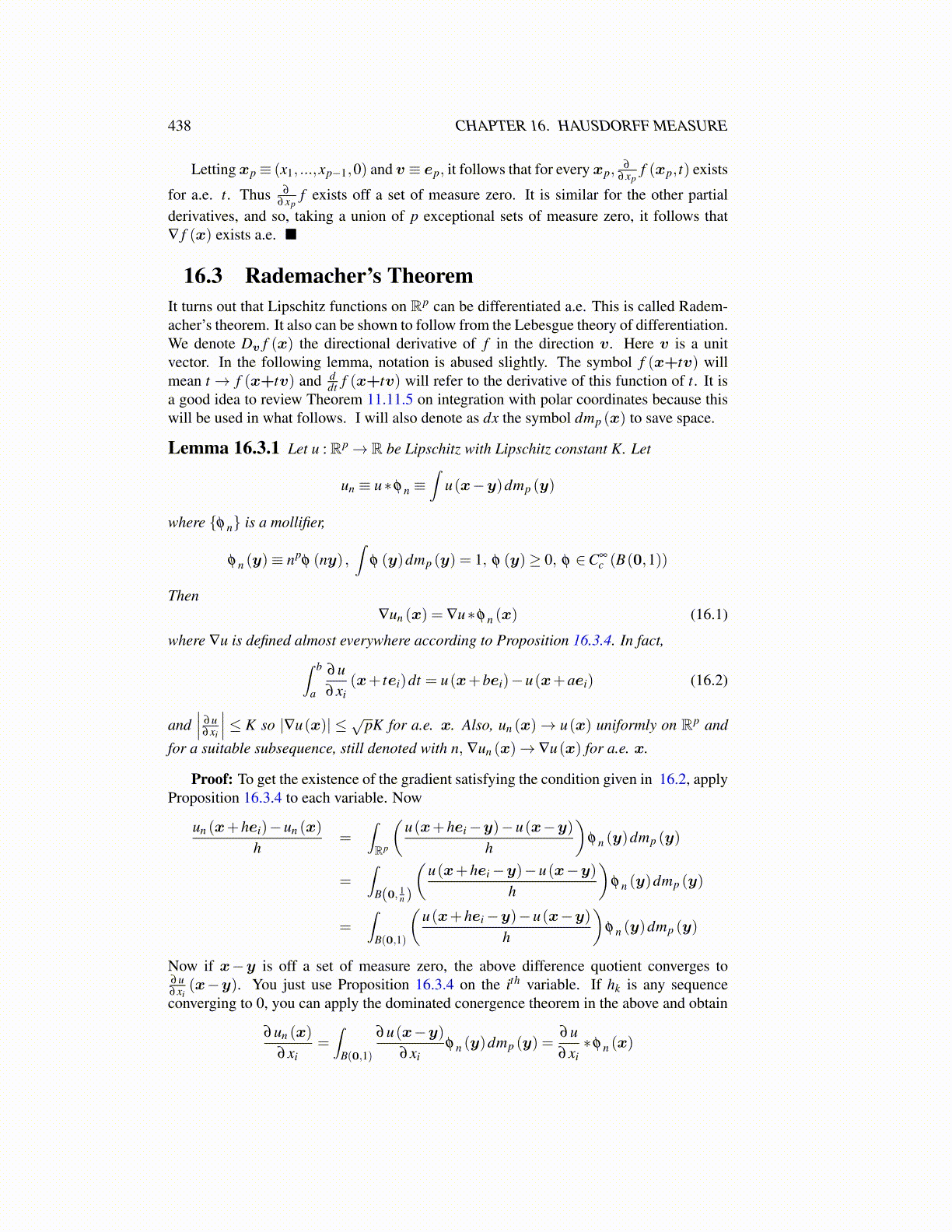
438 CHAPTER 16. HAUSDORFF MEASURE
Letting xp≡ (x1, ...,xp−1,0) and v ≡ ep, it follows that for every xp,∂
∂xpf (xp, t) exists
for a.e. t. Thus ∂
∂xpf exists off a set of measure zero. It is similar for the other partial
derivatives, and so, taking a union of p exceptional sets of measure zero, it follows that∇ f (x) exists a.e. ■
16.3 Rademacher’s TheoremIt turns out that Lipschitz functions on Rp can be differentiated a.e. This is called Radem-acher’s theorem. It also can be shown to follow from the Lebesgue theory of differentiation.We denote Dv f (x) the directional derivative of f in the direction v. Here v is a unitvector. In the following lemma, notation is abused slightly. The symbol f (x+tv) willmean t → f (x+tv) and d
dt f (x+tv) will refer to the derivative of this function of t. It isa good idea to review Theorem 11.11.5 on integration with polar coordinates because thiswill be used in what follows. I will also denote as dx the symbol dmp (x) to save space.
Lemma 16.3.1 Let u : Rp→ R be Lipschitz with Lipschitz constant K. Let
un ≡ u∗φ n ≡∫
u(x−y)dmp (y)
where {φ n} is a mollifier,
φ n (y)≡ npφ (ny) ,
∫φ (y)dmp (y) = 1, φ (y)≥ 0, φ ∈C∞
c (B(0,1))
Then∇un (x) = ∇u∗φ n (x) (16.1)
where ∇u is defined almost everywhere according to Proposition 16.3.4. In fact,∫ b
a
∂u∂xi
(x+ tei)dt = u(x+bei)−u(x+aei) (16.2)
and∣∣∣ ∂u
∂xi
∣∣∣ ≤ K so |∇u(x)| ≤ √pK for a.e. x. Also, un (x)→ u(x) uniformly on Rp and
for a suitable subsequence, still denoted with n, ∇un (x)→ ∇u(x) for a.e. x.
Proof: To get the existence of the gradient satisfying the condition given in 16.2, applyProposition 16.3.4 to each variable. Now
un (x+hei)−un (x)
h=
∫Rp
(u(x+hei−y)−u(x−y)
h
)φ n (y)dmp (y)
=∫
B(0, 1n )
(u(x+hei−y)−u(x−y)
h
)φ n (y)dmp (y)
=∫
B(0,1)
(u(x+hei−y)−u(x−y)
h
)φ n (y)dmp (y)
Now if x−y is off a set of measure zero, the above difference quotient converges to∂u∂xi
(x−y). You just use Proposition 16.3.4 on the ith variable. If hk is any sequenceconverging to 0, you can apply the dominated conergence theorem in the above and obtain
∂un (x)
∂xi=∫
B(0,1)
∂u(x−y)∂xi
φ n (y)dmp (y) =∂u∂xi∗φ n (x)